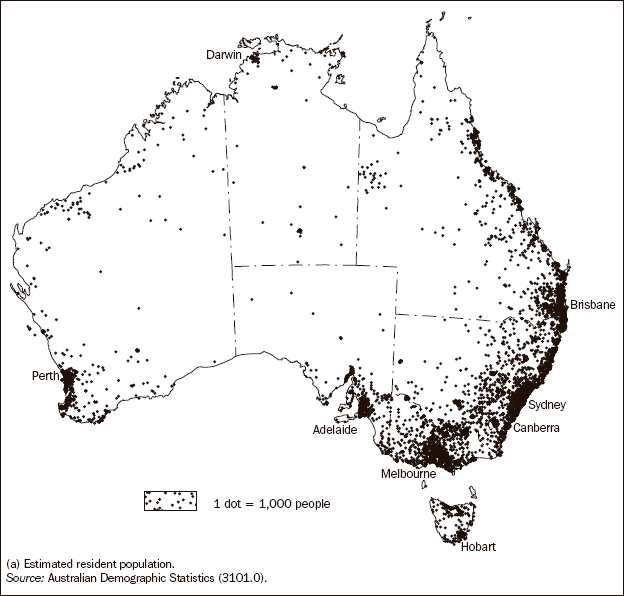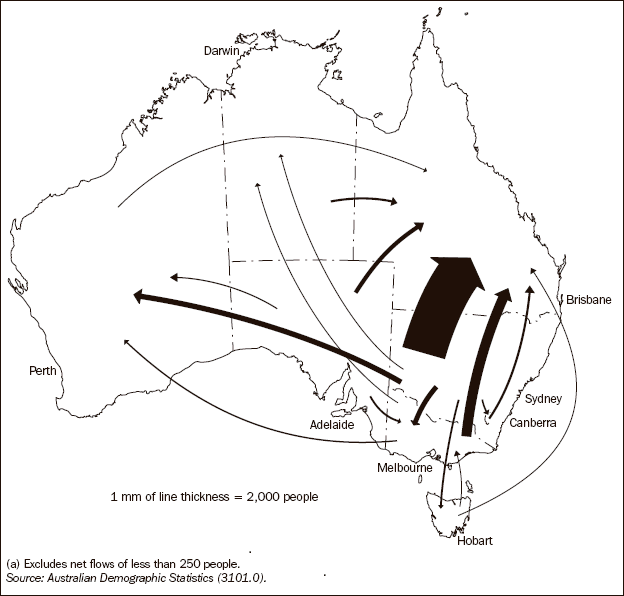GEOGRAPHIC DISTRIBUTION OF THE POPULATION
Most of Australia's population is concentrated in two widely separated coastal regions - the south-east and east, and the south-west. Of the two regions, the south-east and east is by far the largest in area and population. The population within these regions is concentrated in urban centres, particularly the state and territory capital cities.
Australia's population density at June 2006 was 2.7 people per square kilometre (sq km), compared with 2.5 people per sq km in 2001. Of the states and territories, the Australian Capital Territory had the highest population density at June 2006 with 142.1 people per sq km (reflecting the fact that the city of Canberra constitutes a large proportion of the Australian Capital Territory's area), followed by Victoria with 22.6 people per sq km. The Northern Territory had a population density of only 0.2 people per sq km, the lowest of all the states and territories (reflecting more recent settlement, distance from areas settled earlier, large arid areas and, perhaps, climate).
Population density at June 2006 was highest in the city centres, particularly in the Sydney Statistical Division where the three most densely populated Statistical Local Areas (SLAs) in Australia were located. These were Sydney (C) - East (with 8,100 people per sq km); Sydney (C) - West (7,200) and Waverley (A) (6,900), which is just east of the city centre and includes the beach suburbs of Coogee, Bronte and Bondi Beach. The most densely populated SLA in Victoria was Melbourne (C) - Inner with 6,600 people per sq km and was the fourth most densely populated SLA in the country. Port Phillip (C) - St. Kilda, which is on the shores of the bay just south of the city centre, with 6,000 people per sq km, completes the list of Australian SLAs that had more than 6,000 people per sq km at June 2006. At the other extreme, there were over 250 SLAs in Australia with less than one person per sq km. The geographic distribution of Australia's population at June 2006 is shown in map 7.18.
7.18 Population distribution(a) - June 2006

Regional population change
At June 2006, capital city Statistical Divisions (SDs) were home to 13.2 million people, or around two-thirds (64%) of Australia's population. The capital city SD of Melbourne experienced the largest increase in population of capital cities between 2001 and 2006, followed by Brisbane and Sydney. In terms of percentage growth, however, Brisbane was the fastest growing capital city between 2001 and 2006, with an average annual growth rate of 2.2% per year. Perth experienced the second highest average annual growth rate over this period (1.8%). Table 7.19 illustrates the changes in population of Australia's major regions over the five-year period 2001-06.
Generally, the largest growth outside capital city SDs occurred in Australia's coastal regions. Of these regions, the largest increase in population between 2001 and 2006 occurred in Gold Coast-Tweed, up by an average 18,000 people per year (or 3.6% per year). Hervey Bay recorded the fastest growth over the same period with an average growth rate of 5.1% per year. Sunshine Coast and Mackay, also in Queensland, had an average annual growth rate of 3.8% and 3.7% per year respectively, during the same period.
7.19 ESTIMATED RESIDENT POPULATION, By major regions(a) |
|  |
 | June 2001 | June 2006 | Change from 2001 to 2006 |  |
 | '000 | '000 | no. | %(b) |  |
Capital city statistical division |  |
|  |
| Sydney | 4 128 272 | 4 284 379 | 156 107 | 0.7 |  |
| Melbourne | 3 471 625 | 3 744 373 | 272 748 | 1.5 |  |
| Brisbane | 1 629 133 | 1 820 400 | 191 267 | 2.2 |  |
| Adelaide | 1 107 986 | 1 146 119 | 38 133 | 0.7 |  |
| Perth | 1 393 002 | 1 519 510 | 126 508 | 1.8 |  |
| Greater Hobart | 197 282 | 205 566 | 8 284 | 0.8 |  |
| Darwin | 106 842 | 114 368 | 7 526 | 1.4 |  |
| Canberra | 318 939 | 333 940 | 15 001 | 0.9 |  |
Statistical district |  |
|  |
| Newcastle (NSW) | 492 549 | 517 496 | 24 947 | 1.0 |  |
| Wollongong (NSW) | 269 597 | 277 972 | 8 375 | 0.6 |  |
| Nowra-Bomaderry (NSW) | 30 168 | 32 245 | 2 077 | 1.3 |  |
| Lismore (NSW) | 30 871 | 31 565 | 694 | 0.4 |  |
| Coffs Harbour (NSW) | 46 099 | 50 048 | 3 949 | 1.7 |  |
| Port Macquarie (NSW) | 38 130 | 41 348 | 3 218 | 1.6 |  |
| Tamworth (NSW) | 42 510 | 44 371 | 1 861 | 0.9 |  |
| Dubbo (NSW) | 35 191 | 35 834 | 643 | 0.4 |  |
| Wagga Wagga (NSW) | 52 120 | 55 195 | 3 075 | 1.2 |  |
| Bathurst (NSW) | 30 615 | 32 246 | 1 631 | 1.0 |  |
| Orange (NSW) | 36 999 | 37 009 | 10 | - |  |
| Albury-Wodonga (NSW/Vic.) | 95 621 | 100 826 | 5 205 | 1.1 |  |
| Geelong (Vic.) | 159 503 | 167 802 | 8 299 | 1.0 |  |
| Warrnambool (Vic.) | 29 629 | 31 501 | 1 872 | 1.2 |  |
| Ballarat (Vic.) | 83 599 | 88 437 | 4 838 | 1.1 |  |
| Bendigo (Vic.) | 79 673 | 85 080 | 5 407 | 1.3 |  |
| Shepparton (Vic.) | 44 876 | 46 227 | 1 351 | 0.6 |  |
| La Trobe Valley (Vic.) | 74 996 | 76 339 | 1 343 | 0.4 |  |
| Mildura (Vic.) | 45 294 | 47 911 | 2 617 | 1.1 |  |
| Sunshine Coast (Qld) | 186 144 | 224 127 | 37 983 | 3.8 |  |
| Bundaberg (Qld) | 56 806 | 63 262 | 6 456 | 2.2 |  |
| Hervey Bay (Qld) | 39 599 | 50 825 | 11 226 | 5.1 |  |
| Rockhampton (Qld) | 67 369 | 73 333 | 5 964 | 1.7 |  |
| Gladstone (Qld) | 39 100 | 45 678 | 6 578 | 3.2 |  |
| Mackay (Qld) | 64 767 | 77 544 | 12 777 | 3.7 |  |
| Townsville (Qld) | 134 073 | 152 954 | 18 881 | 2.7 |  |
| Cairns (Qld) | 112 932 | 131 564 | 18 632 | 3.1 |  |
| Toowoomba (Qld) | 109 449 | 121 894 | 12 445 | 2.2 |  |
| Gold Coast-Tweed (Qld/NSW) | 474 753 | 565 256 | 90 503 | 3.6 |  |
| Mandurah (WA) | 59 752 | 71 011 | 11 259 | 3.5 |  |
| Bunbury (WA) | 50 008 | 57 744 | 7 736 | 2.9 |  |
| Kalgoorlie/Boulder (WA) | 29 383 | 30 196 | 813 | 0.5 |  |
| Geraldton (WA) | 31 425 | 33 500 | 2 075 | 1.3 |  |
| Launceston (Tas.) | 98 526 | 103 325 | 4 799 | 1.0 |  |
| Burnie-Devonport (Tas.) | 77 480 | 79 932 | 2 452 | 0.6 |  |
| Canberra-Queanbeyan (ACT/NSW) | 360 537 | 381 397 | 20 860 | 1.1 |  |
|  |
| - nil or rounded to zero (including null cells) |
| (a) Based on 2006 Australian Standard Geographical Classification boundaries. |
| (b) Average annual growth rate. |
| Source: Regional Population Growth, Australia (3218.0). |
Interstate migration
The main factor changing the distribution of Australia's population has been internal migration. During 2005-06, 342,500 people moved from one state or territory to another. This is 16,400 fewer people than in the previous year.
7.20 Net interstate migration(a)

In 2005-06 Queensland, Western Australia, Tasmania and the Australian Capital Territory all experienced net interstate migration gains, while New South Wales, Victoria, South Australia and the Northern Territory experienced net interstate migration losses. Queensland has experienced positive net interstate migration for more than 30 years; in contrast, New South Wales has experienced net losses every year since 1978-79. As table 7.21 illustrates however, any losses due to interstate migration in 2005-06 were offset by growth due to natural increase and/or net overseas migration.
7.21 Population growth rates - 2005-06 |
|  |
 | NSW | Vic. | Qld | SA | WA | Tas. | NT | ACT | Aust.(a) |  |
 | % | % | % | % | % | % | % | % | % |  |
|  |
| Natural increase | 0.60 | 0.63 | 0.73 | 0.38 | 0.76 | 0.52 | 1.37 | 0.87 | 0.64 |  |
| Net overseas migration | 0.63 | 0.76 | 0.53 | 0.61 | 1.07 | 0.14 | 0.41 | -0.03 | 0.66 |  |
| Net interstate migration | -0.35 | -0.04 | 0.64 | -0.18 | 0.15 | 0.01 | -0.19 | 0.08 | - |  |
| Total population growth | 0.91 | 1.52 | 2.14 | 0.99 | 2.07 | 0.70 | 1.98 | 1.24 | 1.43 |  |
|  |
| - nil or rounded to zero (including null cells) |
| (a) Includes Other Territories. Other Territories comprise Jervis Bay Territory, Christmas Island and the Cocos (Keeling) Islands. |
| Source: Australian Demographic Statistics (3101.0). |
Queensland was the most popular destination for Australians moving interstate, receiving the largest number of arrivals during 2005-06 (98,300 persons). New South Wales and Victoria followed with 81,100 and 62,500 arrivals respectively.
The most common moves were between the three most populous states: New South Wales, Victoria and Queensland. The largest interstate flow was from New South Wales to Queensland (51,000 persons), while the counter-flow from Queensland to New South Wales was the second largest (33,200 persons). The third largest flow was from New South Wales to Victoria (23,300 persons), followed by the flow from Victoria to New South Wales (21,300).
There were also significant movements between bordering states and territories. This is especially apparent between the Australian Capital Territory and surrounding New South Wales, with 10,700 arrivals to the Australian Capital Territory from New South Wales and 10,000 departing from the Australian Capital Territory to New South Wales in 2005-06.
The largest net flow in 2005-06 was between New South Wales and Queensland, with Queensland gaining a net 17,800 from New South Wales. The second largest net movement was between Victoria and Queensland, with Queensland gaining a net 4,000 people from Victoria.
 Print Page
Print Page